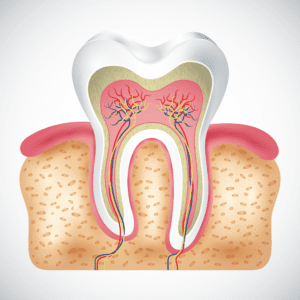 What comes to mind first when your dentist says you may need a root canal? The initial reaction for many is to cringe and immediately think of the excruciating pain they may experience. Believe it or not, root canal procedures are not actually painful. The procedure itself is considered a pain-relieving treatment. The only pain you will experience is from the infection before it is treated and possibly some discomfort during the healing process. To better understand the facts about root canals, read this step-by-step guide on root canal procedures:
What comes to mind first when your dentist says you may need a root canal? The initial reaction for many is to cringe and immediately think of the excruciating pain they may experience. Believe it or not, root canal procedures are not actually painful. The procedure itself is considered a pain-relieving treatment. The only pain you will experience is from the infection before it is treated and possibly some discomfort during the healing process. To better understand the facts about root canals, read this step-by-step guide on root canal procedures:
Step 1: Cleaning and preparing
In order to clean the inside of the root canal—located in the middle of your tooth—the dentist will place the patient under anesthesia. Right off the bat, the patient is numbed so they do not experience any discomfort.
Most patients undergo root canal treatment to remove infected or already dead tooth pulp from inside the tooth. The pulp of the tooth is full tiny nerves, connective tissue and blood vessels. If infected, these nerves can be hypersensitive and cause extreme pain.
To clear infection from the tooth, the dentist will create a small hole to remove the diseased tissue. Once the tissue is removed, the dentist will use special tools to reshape the canal and prepare it for step two.
Step 2: Filling
Of course, the dentist can’t leave your tooth with a hole. Once all the tissue is removed and the canal has been re-shaped, the tooth is filled with a rubber-like material called gutta-percha. This material will harden and seal the canal completely to avoid future infections.
Step 3: Adding a crown or filling
A tooth without a pulp is considered a very fragile tooth. Root canal treatments save your teeth from decay, but they can also weaken them. Your dentist may recommend adding a crown or special filling for extra protection depending on the location of the tooth in your mouth and the current condition of the tooth. If you clench or grind your teeth, you are more likely to need the extra protection from a dental crown or filling. For incisor and canine teeth that are in great condition, you may not need a crown following a root canal procedure.
Step 4: Aftercare
After aroot canal procedure, your dentist will provide you with instructions for managing any pain and how to take care of your tooth. It is important to follow these aftercare tips to help ensure a smooth recovery:
- Avoid crunchy or hard foods
- Floss and brush gently around the treated area
- Take oral pain relievers as advised (It is important to follow the instructions for medications.)
If you experience a small amount of pain after the root canal procedure do not worry. This is common and can be soothed by following the post-procedure intructionsyour dentist provided you. However, if you are experiencing excruciating pain, contact your dentist immediately for further instruction.
To learn more about root canals procedures, or to schedule a dentist appointment, contact Artistic Dental at (602)840 -5400 or email frontoffice@artisticd.com.
